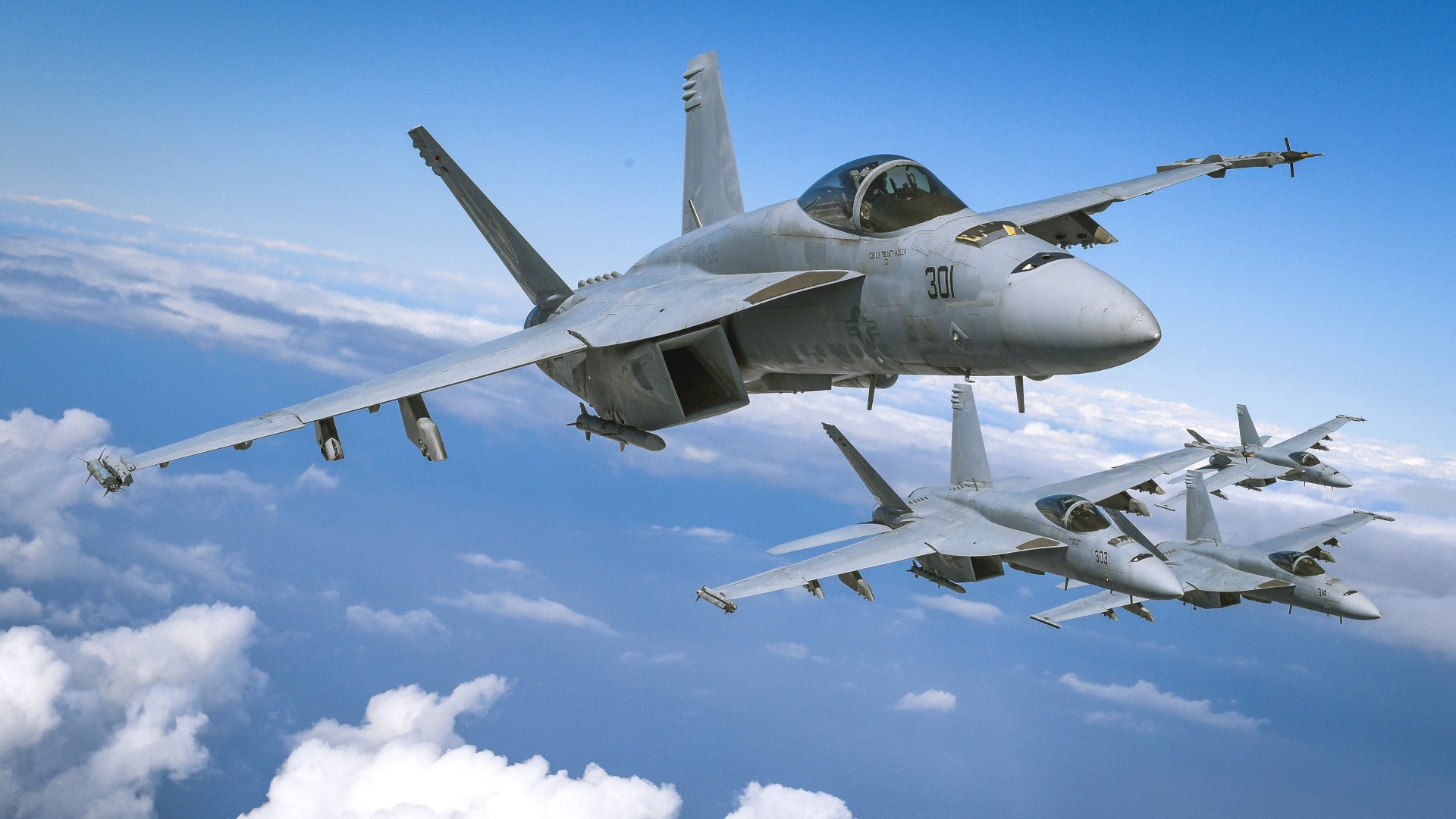Last time we checked in with Boeing about the state of the F/A-18E/F Super Hornet program, the company had already laid out an impressive plan for the jet’s future based around the new Block III configuration, which promises to significantly expand the combat capabilities of the aircraft. We’ve now had a chance to receive an updated brief from Boeing officials on the Super Hornet program, which points to a bright future for the fighter jet, including additional upgrades and potential foreign sales, through the end of the coming decade and beyond.
The War Zone had a chance to sit down and chat with Dan Gillian, the head of Boeing’s F/A-18E/F Super Hornet and EA-18G Growler programs, at the company’s Washington, D.C. offices about both aircraft on Mar. 27, 2019. At present, the U.S. Navy, the largest single customer for these aircraft, is planning to buy 84 F/A-18E/F Super Hornets between the 2020 and 2024 Fiscal Years, according to its latest budget request for the 2020 Fiscal Year. This is on top of the 24 jets the service received funding for in the previous fiscal cycle.
The Navy is not planning on buying any additional Growlers at present, but this could change in the future. Boeing has suggested to the service that an optimal number of EA-18Gs per carrier air wing would be between 8 and 11, rather than the present allotment of five. If the Navy were to pursue this plan, it would have to buy between 24 and 48 additional Growlers in the future to ensure adequate operational capacity.
Still, the Chicago-headquartered planemaker already expects to actually deliver 78 Super Hornets to the Navy as part of a new multi-year contract starting in 2020 and ending in 2023, with additional deliveries stretching out to 2026. The Navy’s latest budget documents show that it is expecting to pay around $66 million for each new Super Hornet in the 2020 Fiscal Year.
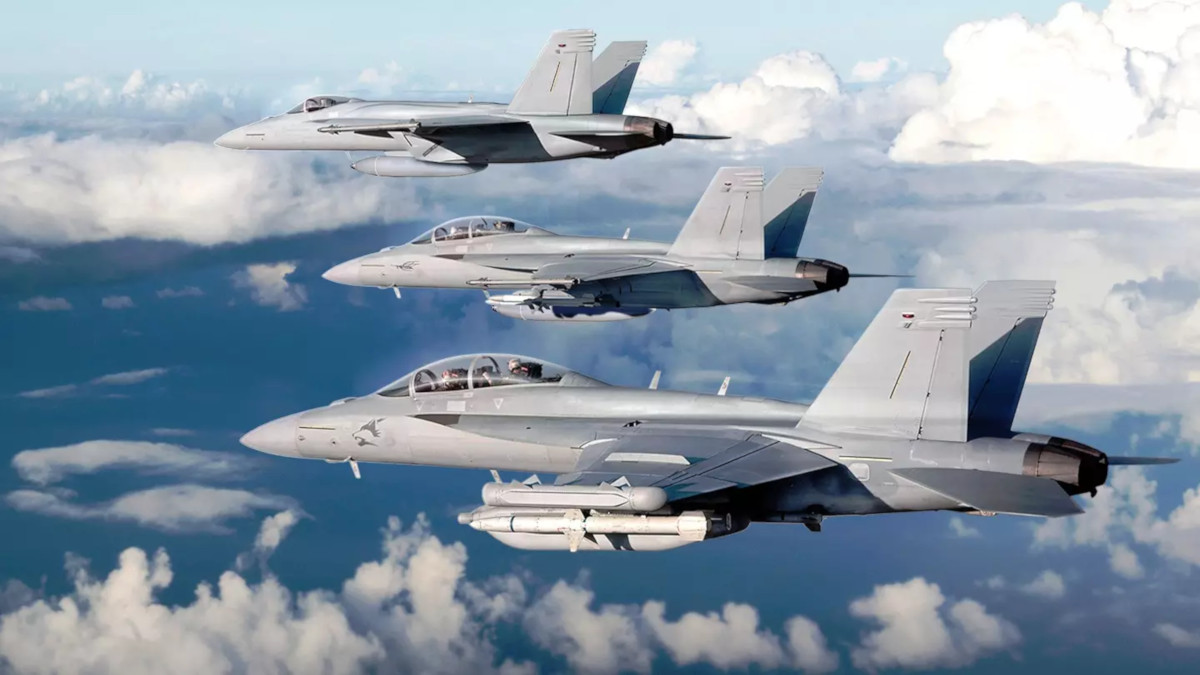
The F/A-18E/F does “continue to enjoy the lowest cost per flight hour of any airplane in the U.S. inventory,” Gillian said, adding that this was around $18,000 per hour at present.
Beyond new-build aircraft, the Navy also expects to begin converting a significant portion of its 540 existing Block II F/A-18E/F to the new Block III configuration in 2022. This upgrade program, which also includes a service life modification (SLM) effort to extend the lifespan of these older aircraft, is projected to run through 2033. The total life expectancy of any Block III Super Hornet, new build or updated, will be around 10,000 flight hours, a fifty percent increase over Block II aircraft.
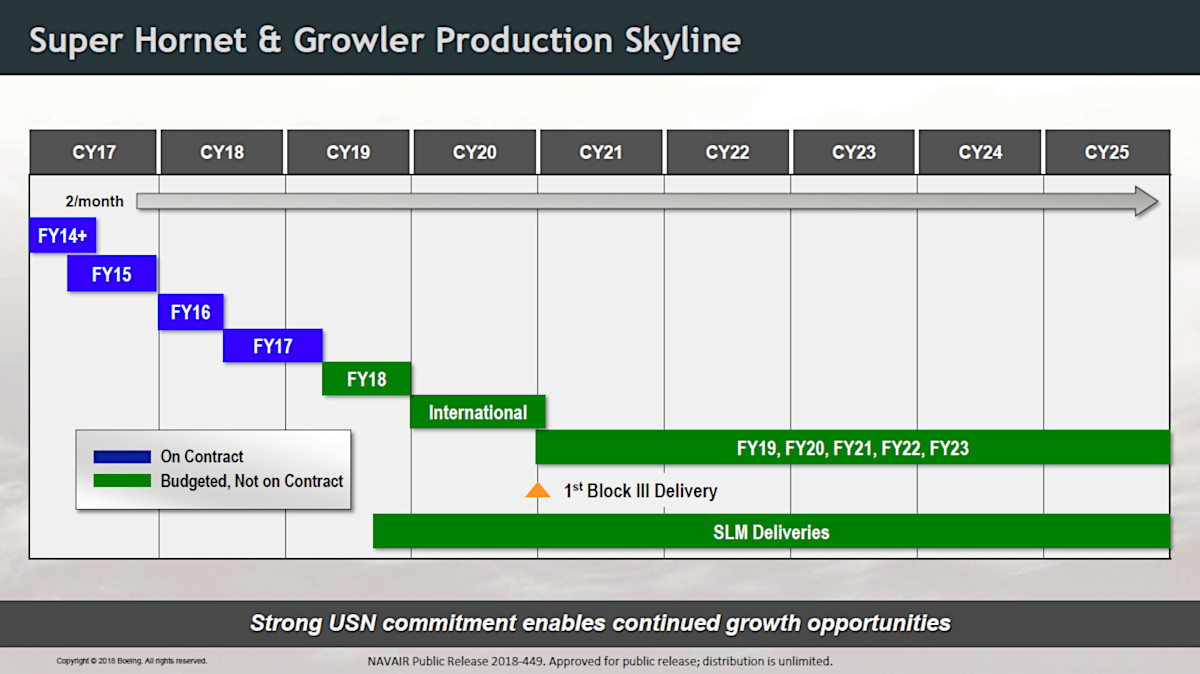
Super Hornets in the Block III configuration will have five major upgrades over the previous Block II types. These include are conformal fuel tanks (CFT), updated and added coatings to reduce its radar signature, a set of new mission computers and data links, and a single, readily customizable wide-area multi-function display will go into each cockpit, including the rear seat on two-seat F/A-18F models.
In addition, two previously planned upgrades to the Block II Super Hornets are getting rolled in with the Block III program. These are the ability to carry a modified centerline drop tank with a networked infrared search and track (IRST) sensor and an improved satellite communications (SATCOM) system. You can read more about these updates in detail in The War Zone‘s past feature on the Block III Super Hornet.
Boeing says it plans to deliver a pair of Super Hornet testbeds to the Navy with various Block III features, including the new multi-function displays, later in 2019. This will help the service begin to develop new concepts of operation based on the added capabilities, allow it to begin devising a plan to transition pilots from Block II to Block III aircraft, as well as support the continued development of the other updated features.
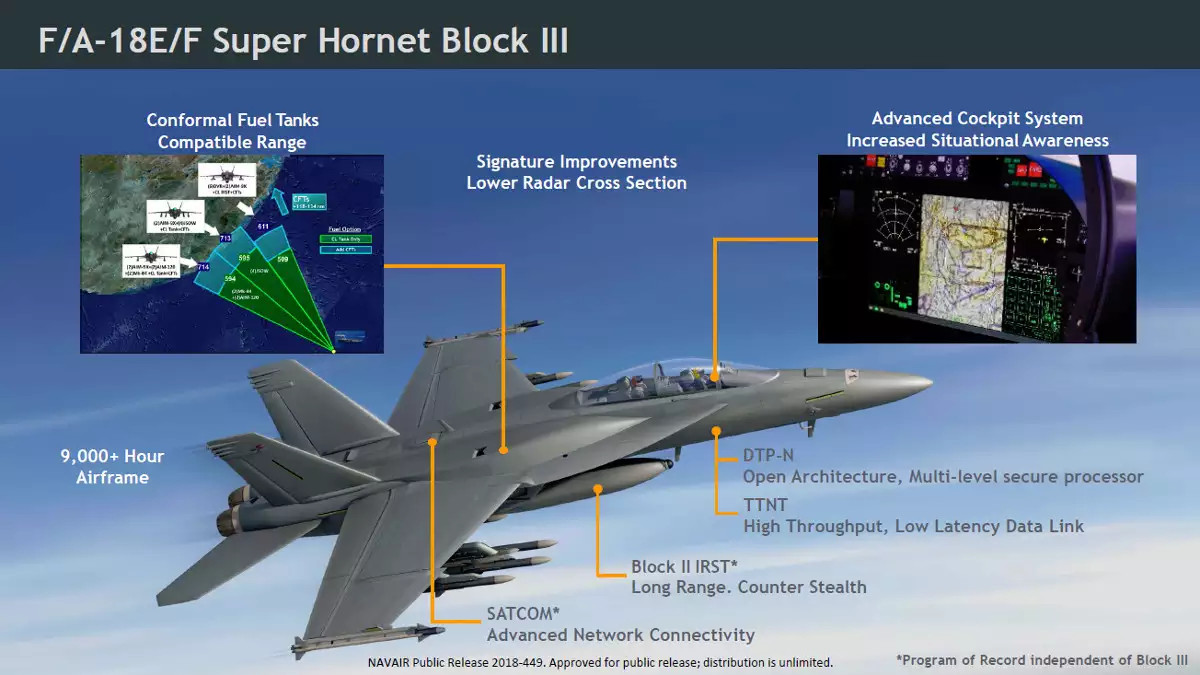
Earlier in 2019, the Navy already completed Phase I of the testing of the CFTs, which focused on ensuring that the Super Hornet flew as intended with empty tanks fitted. Phase II will involve additional flight testing with the tanks actually full of fuel.
Otherwise Boeing says that the development of other Block III features, such as the podded IRST sensor, the added Distributed Targeting Processor-Networked (DTP-N) networking capability to the aircraft’s mission computer, and the new Tactical Targeting Network Technology (TTNT) data link, are all on schedule for delivery of the first jets to the Navy.
The service expects to reach initial operational capability with the new Super Hornets in 2021 and have one squadron of Block III jets per carrier air wing by 2024. This is set to grow to two squadrons in each carrier air wing three years after that.
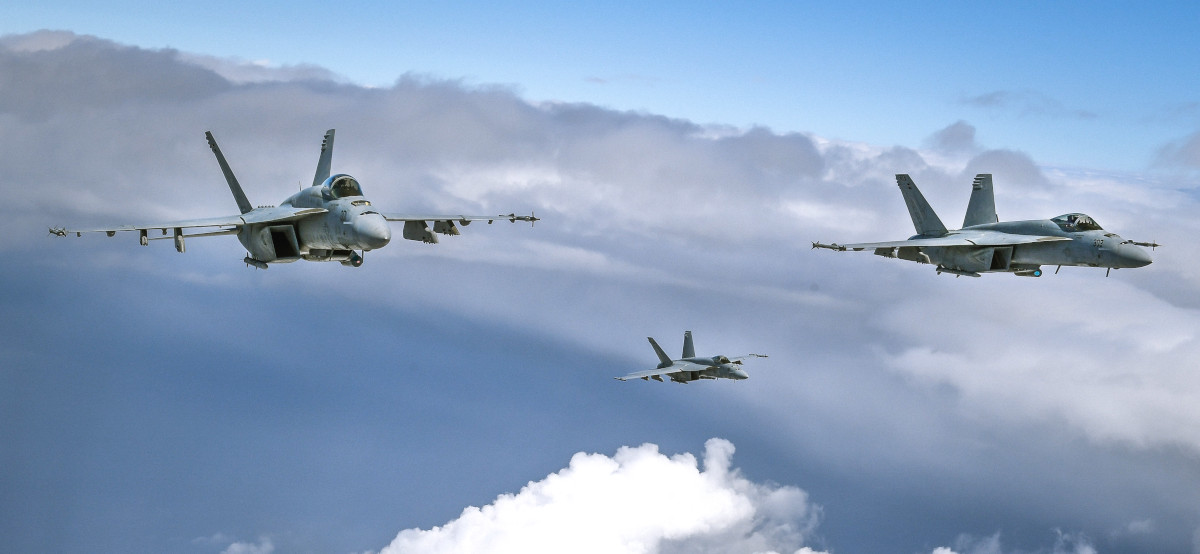
Boeing doesn’t expect the Navy’s Super Hornet upgrade efforts to end with the Block III program. The most significant item that the company is still looking at is the integration of an improved version of the jet’s General Electric F414 engine.
“Obviously, every fighter pilot would like more thrust,” Gillian explained. “But when you look at the kill chain, the Block III story more about being a networked fighter and really unlocking the full potential of the IRST sensor and being able to do [sensor] fusion with all of those carrier air wing assets.”
But Boeing is in ongoing discussions with both the Navy and General Electric about how to proceed on a new engine, even though there is still no formal re-engining effort in place. General Electric has proposed both “Enhanced Durability” and “Enhanced Performance” concepts in the past, that would increase the life expectancy of the engines and performance. The F414-Enhanced Performance Engine (EPE) offered the potential for a 20 percent increase in thrust.
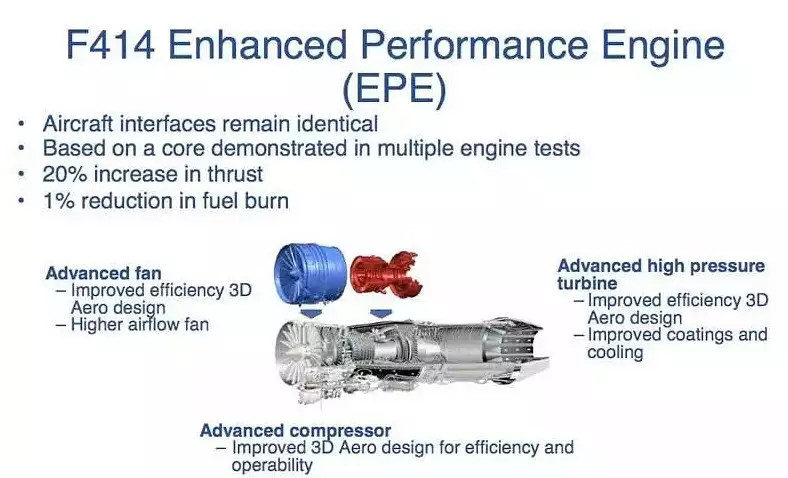
Other enhancements could be coming to the Super Hornet in the future, including an improved electronic warfare suite for self-defense. The jet lacks a missile approach warning system, which is becoming more common on fighter jets, including Boeing’s own F-15 series, which might be a part of any future self-protection upgrades.
There aren’t any firm plans to add hard- or soft-kill active protection systems, such as a directional infrared countermeasures package, but these could be another addition to the defensive suite on Super Hornet or Growler in the future. The Super Hornet does already have an often-overlooked towed decoy system, which the Navy’s latest budget proposal for the 2020 Fiscal Year says is set to get an upgrade of its own in the coming years.
Gillian also said that “manned-unmanned teaming” was a “hot topic” of discussion with the U.S. Navy, among other customers and potential customers. A separate Boeing team recently revealed that it had been working with the Australian government on a “loyal wingman” type unmanned combat air vehicle that would work with that country’s Super Hornets, as well as its Growlers, among other aircraft.

“If you think about an F model Super Hornet, or a Growler, with two aircrew that’s a natural way, a low-risk way to start doing some tactical manned-unmanned teaming work,” Gillian added. The networking and sensor fusion capabilities that the DTP-N and TTNT upgrades offer already provide the “building blocks” for this kind of capability in the future, he explained. He also noted that many potential customers are still working on outlining what they might want out of a future team-up of manned tactical aircraft and drones.
In that same vein, the U.S. military as a whole is looking to increasing integrate artificial intelligence and machine learning into its operations. Super Hornet and Growler might take advantage of these developments in the future. Gillian specifically mentioned the possibility of “cognitive electronic attack” being an option for the Growler, which would involve future systems that could detect, categorize, and and then adapt to new threats, including emitters, such as radars or communications nodes, using previously unknown waveforms, all right in the middle of a mission.
There are things that Boeing says are unlikely to end up on any future Super Hornet variant in the end, too. Previous stealthy concepts involving an IRST sensor integrated into the airframe and enclosed weapons pods, have fallen by the wayside since they first appeared in the company’s proposal for an Advanced Super Hornet in 2013. This aircraft was also referred to as the International Roadmap Super Hornet.
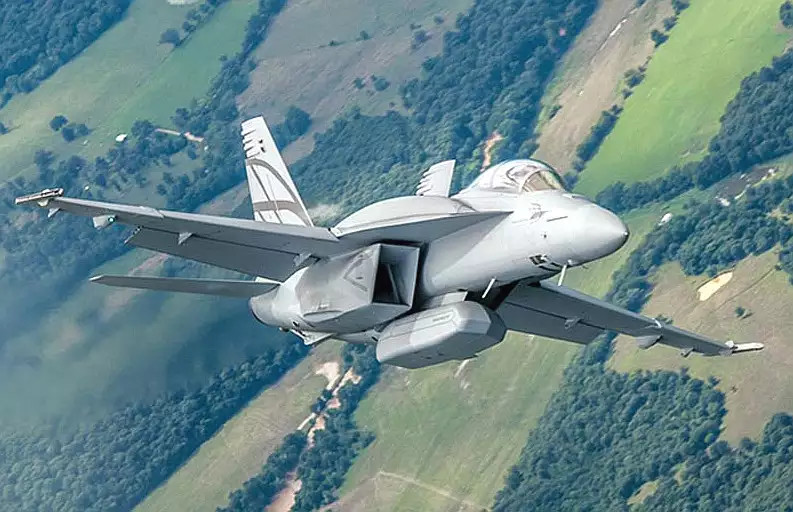
“When you talk stealth, and you’re thinking in the [2020s] and beyond, you have to be stealthy to survive, but just being stealthy will not ensure your survival,” Gillian said. “The threat has figured out how to counter stealth and, obviously, having it is essential, because it does give you advantages, but having to have the highest level of stealth has somewhat been marginalized down to a few niche missions.”
“We continue to say that the right level of stealth – which is where we think we’re at with the Super Hornet, with the Block III Super Hornet – is what the carrier air wing and air forces around the world need to cover the widest swath of missions that a Super Hornet can cover,” he continued. “And then you have the Block III Super Hornet with a long-range IRST sensor – can see a stealth airplane just fine. So as people get more comfortable with that technology, you have to have a more balanced approach to survivability.”
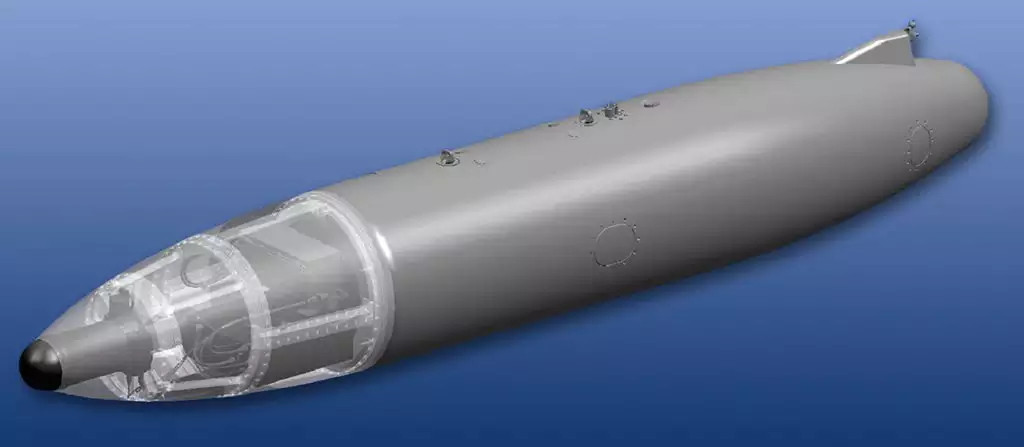
Some or all of the Block III F/A-18E/F upgrades may eventually make their way to the EA-18Gs, as well. The DTP-N and TTNT started life on the Growler to begin with, before making their way to the Super Hornet upgrade program.
Boeing is now looking at the possibility of an Advanced Growler, which the Navy is tentatively referring to as a Block II Growler, that would include the other updates, such as the wide-area cockpit displays and CFTs. The latter addition could be especially valuable for the Growlers, given that these jamming aircraft have to lug around multiple electronic warfare pods, reducing their overall endurance and limiting the available stores stations to carry additional fuel in drop tanks.
“I can certainly see a strong case for a Growler with an enhanced engine, if for no other reason than to generate more electrical power,” Gillian said. The EA-18G could definitely see its demands for electrical power generation grow in the coming years, depending on how the Navy’s multi-part Next Generation Jammer (NGJ) program proceeds. You can read more about the development of these new electronic warfare pods in this past feature.
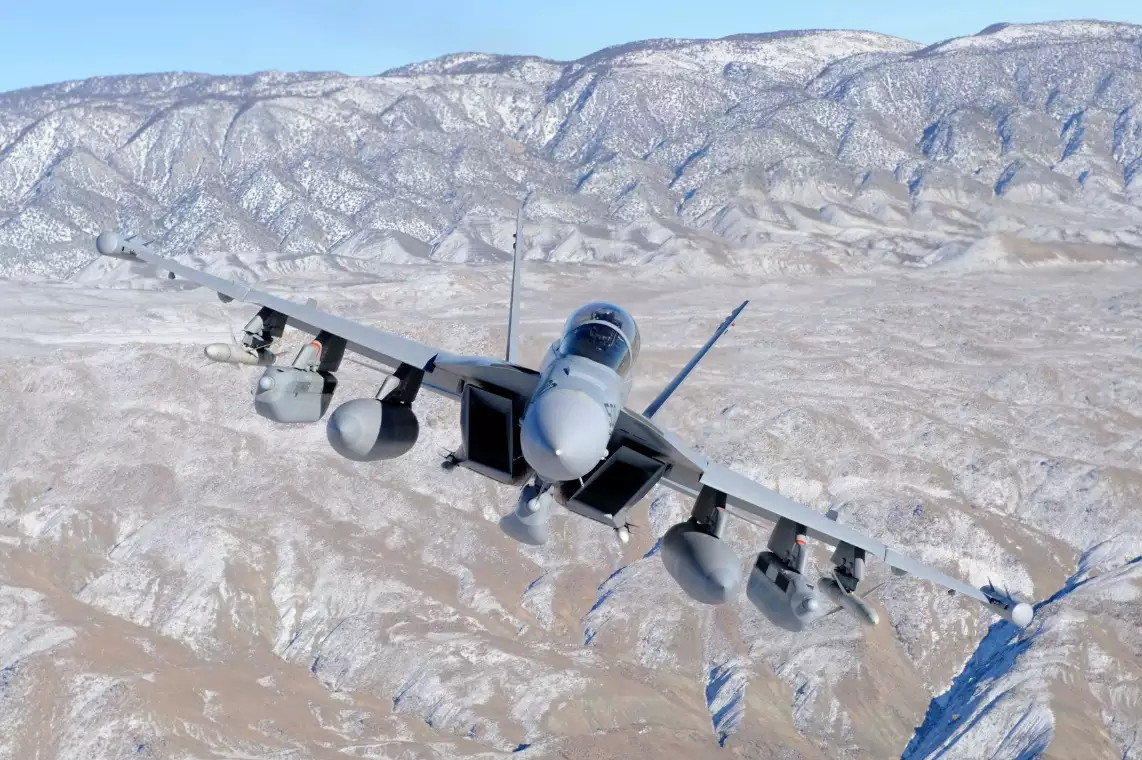
The Navy’s major investments in the Block III Super Hornet also make Boeing “optimistic” about future foreign sales. The planned American purchases have “certainly given a lot of confidence to international customers,” Gillian said.
Kuwait, which has 22 F/A-18Es and six F/A-18Fs on order already, has actually helped fund a number of parts of the Block III program. The Kuwaiti jets will be in a sort of hybrid configuration between Block II and III, receiving some of the upgrades, such as the wide-area cockpit displays. The first of this batch of aircraft is set to fly for the first time in the coming months.
Super Hornets, with various Block III features, are also on offer for current and upcoming fighter competitions in Canada, Finland, Germany, India, Poland, and Switzerland, among others. In many cases, these deals might potentially end up tied together with sales of Growlers, too. Growlers would offer any new operator a quantum leap in electronic warfare capabilities.
Finland is in the process of looking for a replacement for its aging F-18C/D Hornets. Gillian specifically highlighted that the U.S. government had recently approved the sale of EA-18Gs to Finland, along with F/A-18E/Fs, which he felt made the company’s offer to that country particularly strong. “We think that’s a great combination for Finland given the threat environment they operate in,” he said, a nod to the Scandinavian country’s increasingly tense relationship with Russia.
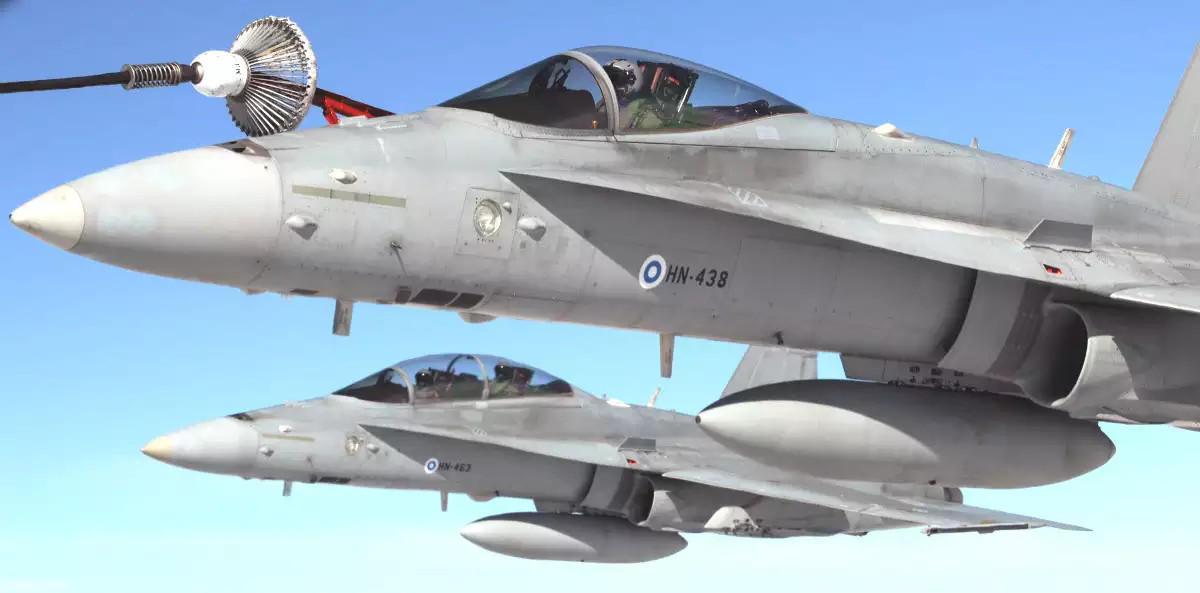
Boeing also plans to offer Growlers to Germany, along with Super Hornets, as the replacement for that country’s fleet of Tornado combat jets, though the U.S government has not yet approved this possible sale of EA-18Gs. The replacement of German Tornados has been its own saga, which you can read about more here, but the country is now set to decide between buying the Super Hornet, possibly with the addition of Growler in the future, or more Eurofighter Typhoons.
Gillian noted that Germany’s Tornado fleet includes a number of examples of the Electronic Combat/Reconnaissance variant, or ECR, which has added equipment specifically for the suppression of enemy air defenses mission (SEAD), including sensors to spot and locate enemy radars and other emitters. This is one of Growler’s missions sets, as well, which would make it an ideal replacement for those particular aircraft, while also providing a massive boost in electronic warfare capabilities for the Germany Air Force, overall.
There is still a nagging question about when any Tornado replacement might be able to perform the Tornado’s present nuclear mission. As part of an inter-NATO agreement, Germany’s Tornado’s are certified to carry U.S. B61 nuclear gravity bombs if required.

Neither Super Hornet nor Typhoon is presently nuclear certified, which could lead to a pause in Germany’s participation in the nuclear sharing deal. “We certainly think that we, working with the U.S. government, can meet the German requirements there on the [German’s] timeline,” Gillian said regarding this issue.
Boeing is still eyeing a possible Super Hornet sale to Canada. Canada had previously planned to buy F/A-18E/Fs as an interim solution to its growing fighter jet woes, which you can read about more here, but this ran afoul of a trade dispute between Boeing and Canadian company Bombardier.
The Canadians subsequently made a controversial purchase of ex-Australian F/A-18A/B Hornets as a stopgap measure instead. Super Hornet is still in the running for the future contract to replace Canada’s existing Hornet fleet outright. Boeing is of the view that the jets, especially with at least some Block III features, such as the podded IRST and CFTs, would be well suited to the Canadian mission, which has a major air defense component.
Canadian jets with the added endurance of the CFTs and increased ability to spot stealthy aircraft at long range using the IRST could be a boon for defending North America from outside threats as part of the U.S.-Canada North American Aerospace Defense Command (NORAD). They would also be valuable for supporting rotating air policing missions in Europe as part of NATO.
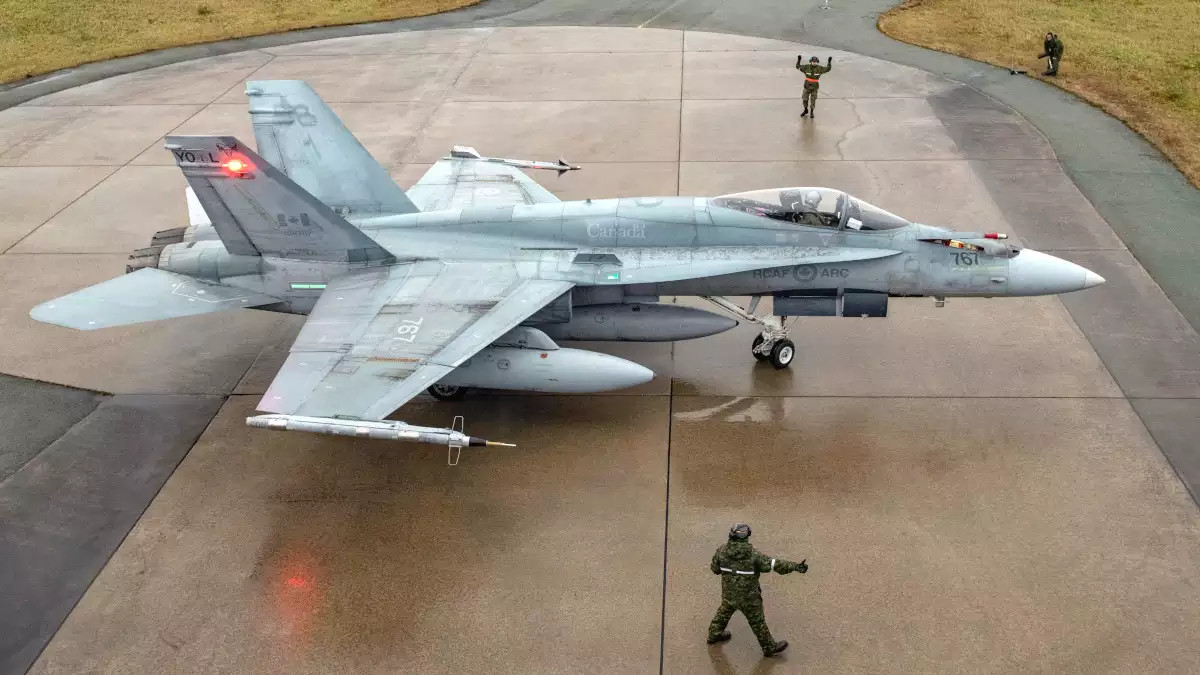
Super Hornets will also be flying in Switzerland later in 2019 as part of that country’s competition to replace its existing F/A-18C/D Hornets, as well as its remaining F-5E/F Tiger IIs. The Swiss have already retired the bulk of their F-5s, with the U.S. Navy now asking for money in the 2020 Fiscal Year to buy more than 20 Tiger IIs sitting in storage in Switzerland to support its adversary training requirements, as well as that of the U.S. Marine Corps.
Beyond that, Super Hornet is in the running for two major contracts in India. The Indian Navy is looking to buy dozens of new carrier-based fighter jets to support the country’s future aircraft carrier plans and the Indian Air Force has a standing requirement for more than 100 new fighter jets to replace various aging types, including its heavily upgraded Soviet-era MiG-21 Bisons. Unfortunately, Indian defense procurement is its own saga, which you can read about in more depth here, and it is unclear exactly when that country might make a final decision in either case.
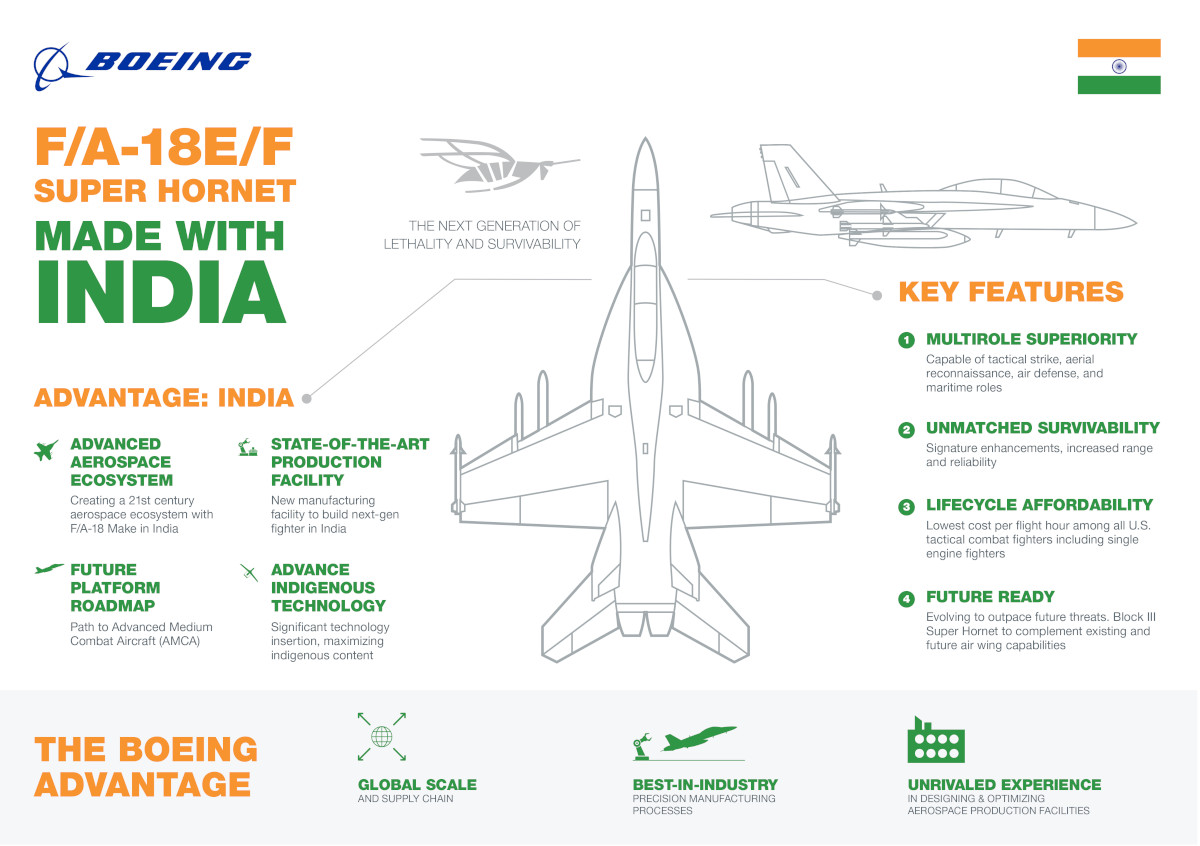
All told, though the Navy remains Boeing’s best Super Hornet customer, the future of the jet, as well as the Growler, looks bright, both in terms of additional capabilities down the road and growing sales abroad. The big questions about whether any of these aircraft will get a new engine or if the Growlers might get the CFTs are still unanswered, but there are increasingly strong incentives in both cases.
Additional sales overseas could prompt further demands for these improvements and help the Navy shift some of the cost burdens of developing them onto other partners. As noted, the sales of more advanced Super Hornets to Kuwait already helped facilitate the development of the full Block III configuration.
The networking and sensor fusion capabilities found in the Block III, combined with future improvements to the self-protection features on the Super Hornet and Growler, will only help keep the aircraft relevant for years to come. The jets that Boeing delivers in the next decade may also find themselves working directly with unmanned aircraft.
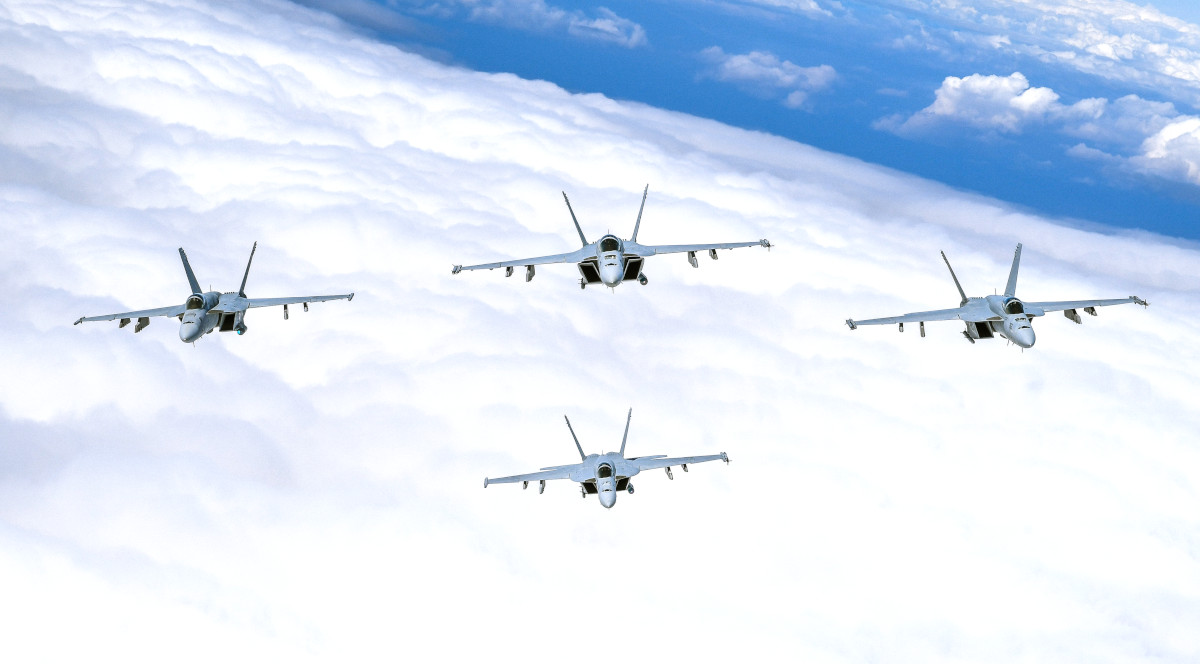
All of this is a major turnaround for the Super Hornet, even just compared to how things were even two years ago. Before defense spending significantly increased under President Donald Trump’s Administration, Boeing was concerned that it might have to close down the entire production line. Things are very different now.
With this year marking the 20th anniversary of the F/A-18E/F’s entry into U.S. service, the prospects look good for the Super Hornet, as well as the Growler, to still be going strong on its 30th birthday.
Correction: The article originally said that Super Hornet costs are rising. The unit cost that the U.S. Navy is paying will drop significantly between the 2019 Fiscal Year and the upcoming 2020 Fiscal Year. Boeing has also now revealed that the full life expectancy of new Block III jets and upgraded aircraft will be around 10,000 flight hours rather than “over 9,000 flight hours.”
Contact the author: jtrevithickpr@gmail.com
